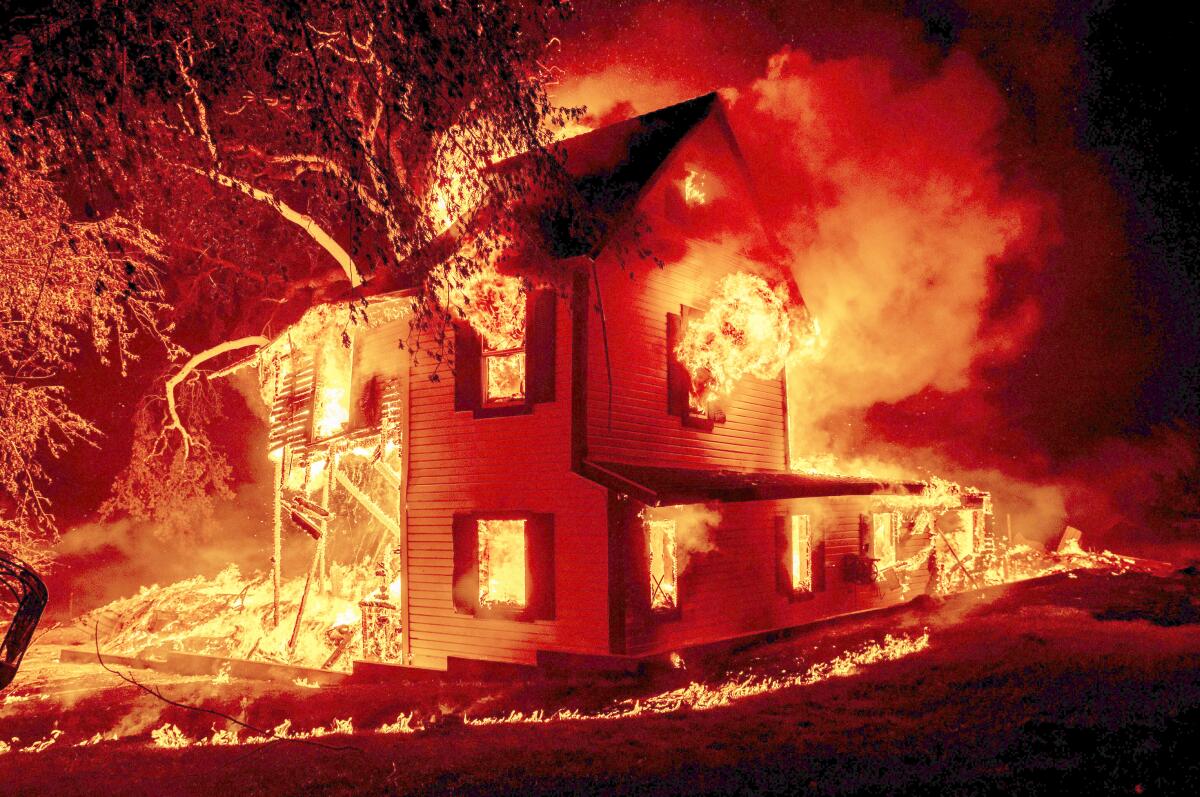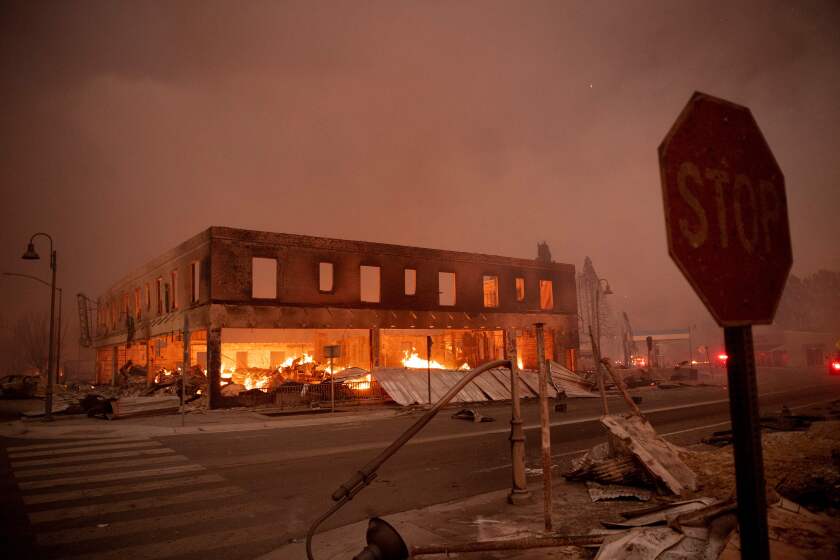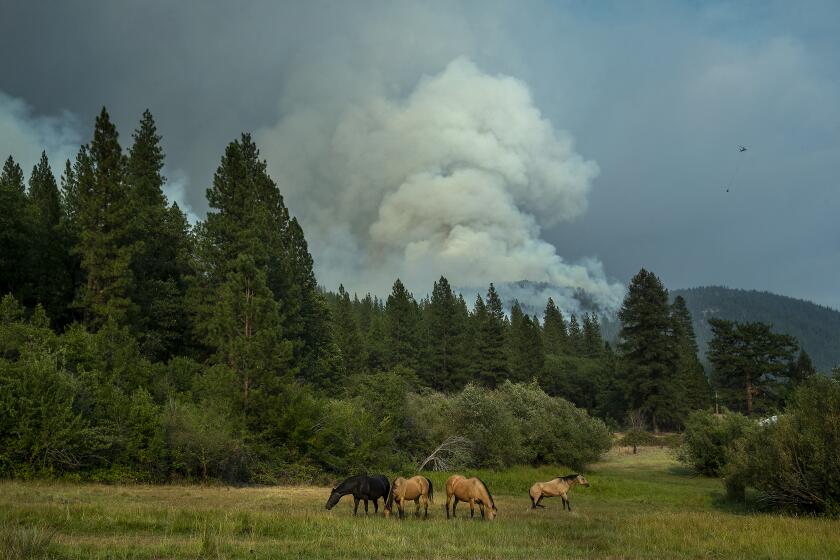PG&E starts planned power shutoffs to 51,000 customers as Dixie fire rampages

- Share via
Pacific Gas & Electric Co. started its planned power shutoff Tuesday evening as the Dixie fire exploded past 600,000 acres and sent more people fleeing from their homes.
The utility said it may cut power to 51,000 residents across 18 counties in Northern California as it monitors forecasted fierce winds that threaten to knock trees and other debris into energized power lines and spark new fires. Preemptively cutting power is intended to reduce the risk of that happening.
“It’s a decision of last resort for us; it’s to prevent a catastrophic wildfire,” said Deanna Contreras, a public information officer for PG&E. Winds, she said, are expected to gust up to 40 mph, with localized gusts up to 50 mph.
Power outages were set to occur in the these counties at these times:
- 5 p.m.: Shasta, Tehama and Yolo
- 6 p.m.: Butte, Colusa, Contra Costa, Glenn, Lake, Lassen, Mendocino, Napa, Plumas, Solano and Sonoma
- 7 p.m.: Trinity
- 10 p.m.: Alameda, Sierra and Yuba
A red flag warning signaling critical fire weather for the Dixie fire burn area is in effect through 8 p.m. Wednesday, according to the National Weather Service’s office in Sacramento. Low humidity, warm temperatures and historically dry vegetation have plagued the region for weeks, fueling rapid fire growth and fire behavior that has baffled seasoned personnel.
Pacific Gas & Electric is under rising scrutiny this summer as a series of huge fires across Northern California have raged amid hot, dry conditions.
Most of the customers who could lose power are in Butte and Shasta counties, the utility said in a statement.
The timing of the shutoffs will be tailored to when high winds move into a particular location, Contreras said. Utility officials aim to restore power 24 hours after the weather clears, she added. Sometimes that equates to 12 daylight hours because lines are patrolled by helicopters.
Shutoffs are not unprecedented. The utility in January cut power for roughly 5,100 people in seven counties. There were six shutoffs initiated last year.
When there’s a risk of a blackout, how do you prepare? And what should you do — and not do — when one is happening and after it’s over?
PG&E has said its equipment may have sparked the massive Dixie fire, which broke out July 13 near where a tree fell into a power line. The utility’s equipment may also have ignited the Fly fire, a blaze that eventually merged with Dixie.
As of Tuesday morning, the Dixie fire had swelled to 604,511 acres and was 31% contained. Updated figures were not available early Tuesday night.
Strong southwest winds sent flames hurtling northeast Monday, threatening the communities of Susanville and Janesville along the eastern edge of the blaze, fire officials said.
Spot fires ignited near Janesville from late Monday afternoon through the early evening, forcing new mandatory evacuations.
“The fire took off, gained momentum, [exhibiting] erratic fire behavior, extreme fire behavior,” said Mark Brunton, operations section chief for the California Department of Forestry and Fire Protection’s Incident Management Team 3.
Fire crews were able to herd the fire around much of the community, but some structures along the Highway 395 corridor were destroyed, he said.
At some point, the blaze leapt over the highway and ignited a roughly 10-acre blaze on the eastern side.
The fire made a six-mile run in one day, authorities said.
“We’re in a situation where we know that wherever it spots, it’s going to start a new fire,” said Mark Beveridge, a spokesperson for the Dixie fire.
Flames also crept around the burn scar of last year’s Sheep fire and pushed toward Susanville, about 11 miles north of Janesville. Residents were told to be ready to leave at any moment. The area remained under imminent threat Tuesday.
More than a month after it ignited near a Pacific Gas and Electric Co. power station, the Dixie fire rages on
“It’s not out of play,” Brunton said, adding that “the next 24 hours is going to be crucial to watch as to what the fire is going to do there.”
Although the cause of the Dixie fire remains under review, prosecutors in at least two counties are investigating PG&E for potential criminal charges, saying it should have been aware of the high risk of fire in the canyon. It is the same canyon where PG&E equipment ignited the 2018 Camp fire. In that blaze, the utility pleaded guilty to 84 counts of manslaughter after the town of Paradise was decimated.
A recent court filing indicated the utility may have played a role in dozens of additional fires.
The utility’s equipment is suspected of igniting at least 62 small fires this season, the utility disclosed in federal court Monday.
The fires, for which PG&E did not provide locations, ranged in size from less than 3 meters to 99 acres and took place between May 10 and July 31 in areas deemed high-fire threat districts, PG&E said in the filing.
One fire, reported June 29, burned 100 to 299 acres, but the majority were a quarter-acre or less, the utility said. No deaths were reported in connection with any of the fires.
The most destructive, which is suspected to have resulted from a bird striking equipment and burned less than 3 meters June 16, destroyed a single structure, the utility said.
Vegetation contact is suspected to have accounted for the majority of the fires — 29 — followed by equipment failure, which is being eyed in 15 fires, the utility said. Other potential causes included contact with a third party, bird or animal and overloaded equipment.
The cause of three of the fires remains under investigation, and one is unknown, the utility said.
More to Read
Sign up for Essential California
The most important California stories and recommendations in your inbox every morning.
You may occasionally receive promotional content from the Los Angeles Times.













